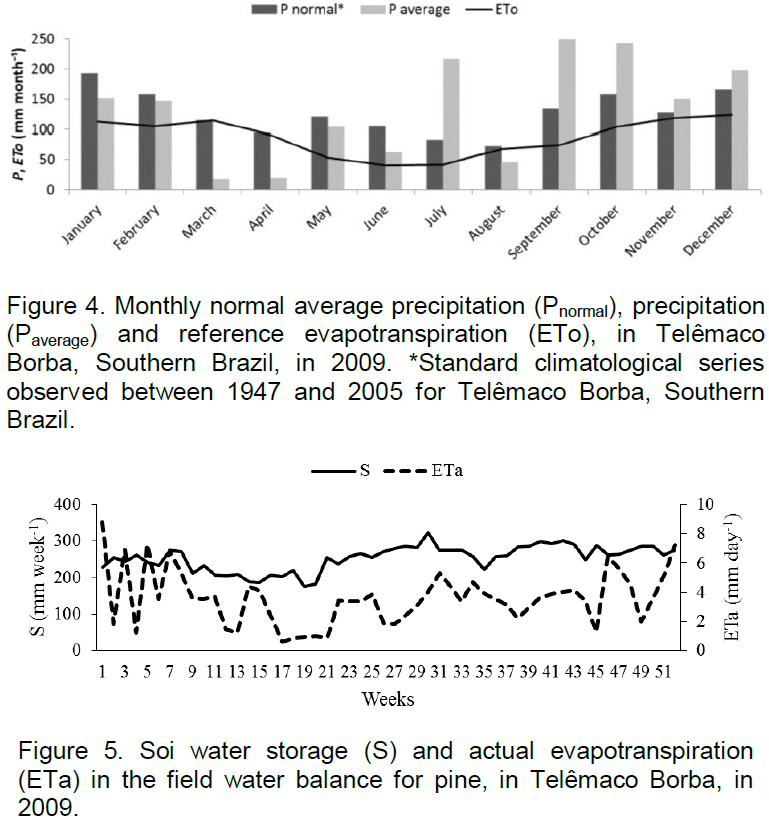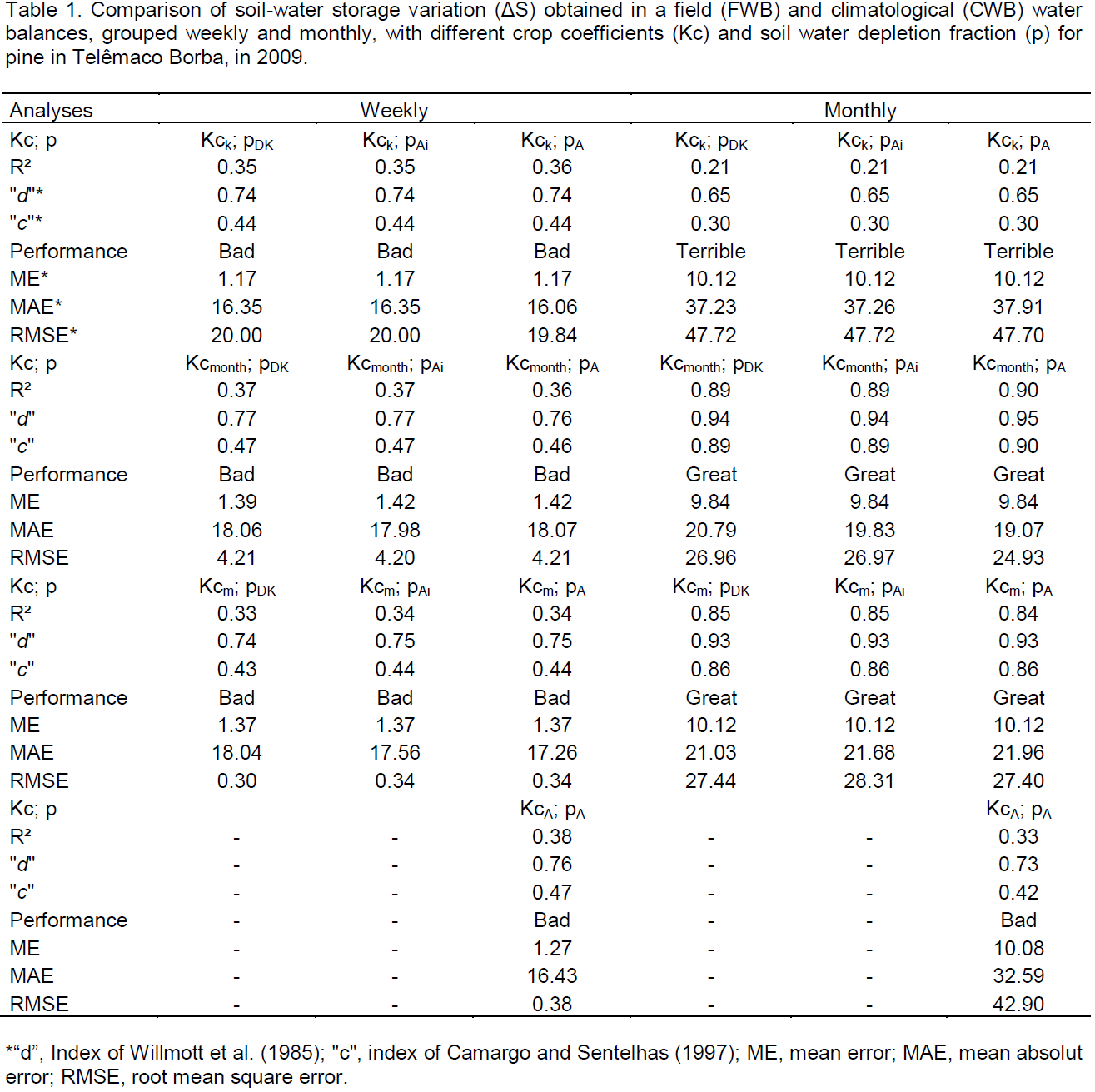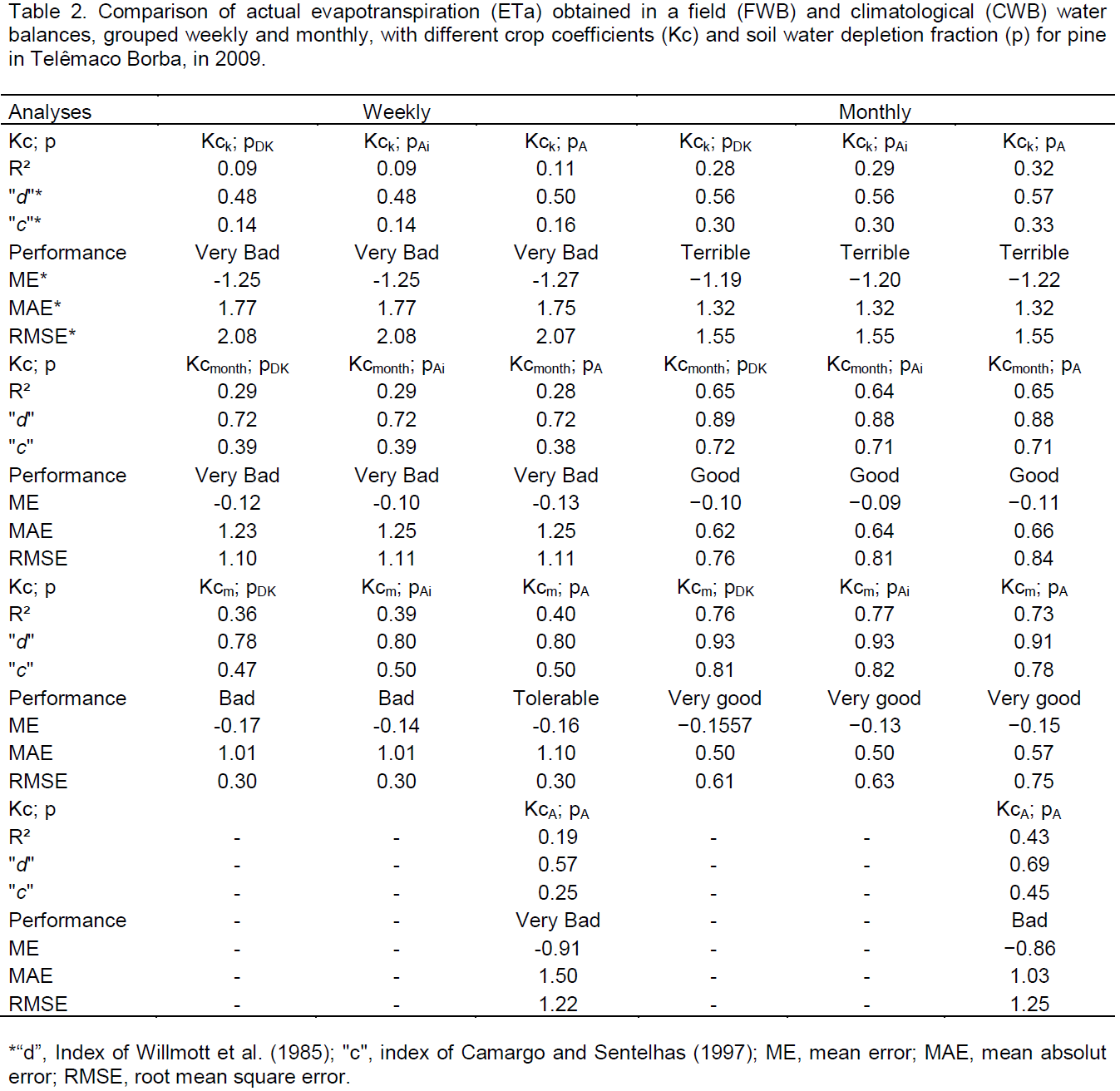ABSTRACT
In comparison to a measured field water balance (FWB), we aimed to evaluate the impact of using different functions to daily estimate the crop coefficient (Kc) and soil water depletion fraction (p) in a climatological water balance (CWB), and verify that the grouping of output variables provides improved results. The FWB was conducted in Telêmaco Borba, Southern Brazil. The data were collected at weekly intervals in 2009, in an area of loblolly pine with 6 years-old. The CWB considers different equations to estimate daily Kc and p values. The output components of the CWB were estimated daily, then weekly and monthly grouped for comparison with the FWB. Linear correlation analysis, index “d” of concordance, index “c” of performance, mean error, mean absolute error and root mean square error were performed in order to compare the water balances, based on the soil-water storage variation (DS) and actual evapotranspiration (ETa). The use of a Kc measured weekly improved the CWB, providing high correlation and small errors in relation to a measured water balance, independent of the comparison scale. On the other hand, the use of a Kc that considers climate variables (Kck) had the worst levels of accuracy and precision, and the biggest mistakes in all analyzes and all tested variables. There was no significant improvement with the daily variation of p, both grouping weeks as in months. The proposed equations do not represent any gain in the CWB, in comparison with the use of a constant p value over time. The estimate of the CWB and its subsequent grouping in months for comparison provided greater degree of accuracy and precision for the variables analyzed, but caused the biggest mistakes. Therefore, the calculation of CWB should be performed with the highest periodicity possible, and grouping the CWB output variables should only be performed for comparison.
Key words: Pinus taeda, crop evapotranspiration, actual evapotranspiration, soil water storage, field water balance.
The field water balance (FWB) is the accounting of inputs and outputs of water at any given volume control over a specific time interval. It can be calculated by means of crop evapotranspiration (ETc) measurement instruments as lysimeters and evapotranspirometers, or by measuring the soil moisture. The monitoring of soil water storage, combined to the understanding about crop needs have been considered important tools to the agroforestry activities planning, improvement of soil water use efficiency by irrigation practices and agroclimatic zoning (Yan et al., 2012; Khazaei and Hosseini, 2015).
The study of water demand in soils under plantation of exotic woods, such as Pinus taeda, assists in the development of alternatives to the rational use of water, which implies in no compromising of the environmental balance and promoting the development of silvicultural activity (Rigatto et al., 2005).
Currently, the FWB is more used in scientific researches and their measures are commonly used to verify mathematical models, which are developed to simulate and perform estimations. Thus, many researchers have sought to develop indirect methods to estimate it from climatic variables, in parts because complete field measurements are time consuming, costly and experimentally difficult depending of the size of the area to be monitored (Zhang et al., 2004; Praveena et al., 2012; Yan et al., 2012).
In this context, the estimated climatological water balance (CWB) is required. However, some input components of CWB do not represents the real conditions of the crop in the field, especially for perennial crops, such as forest species, in relation to the variations in time. Due to the lack of specialized studies and local complexity measurements, the water components are usually estimated empirically and are considered constant over time, such as the crop coefficient (Kc) and soil water depletion fraction (p) (Allen et al., 1998). Using a constant value for these variables can significantly affect the output components, such as crop evapotranspiration (ETc); soil water storage (S); actual evapotranspiration (ETa). Since consistent, the highest frequency of the input data in the CWB generally improve their sensitivity to small variations over time (Khazaei and Hosseini, 2015), making it more reliable for the silvicultural planning.
In comparison to a measured field water balance, we aimed to evaluate the impact of using different equations to daily estimate the crop coefficient (Kc) and soil water depletion fraction (p) in a climatological water balance, and verify that the grouping of output variables provides improved results.
A field water balance (FWB) was conducted in Telêmaco Borba, state of Paraná, Southern Brazil, 24°13′19”S, 50°32′33”W, 700 m altitude (Figure 1). The region has a climate type transitional wet subtropical to temperate (“Cfa/Cfb”) with an average temperature in the coldest month
below 16°C including frost events, and an average temperature in the warmest month above 22°C (Alvares et al., 2013).
This experiment served as a witness, being considered the actual values for comparison with the models proposed in this manuscript. The data were collected at weekly intervals in 2009, in an area of 12.5 ha of 6-years old Pinus taeda planting, with standard spacing of 2.0 × 3.0 m (1,667 trees/ha) in a clay Oxisol with undulated relief. For details of the methodology (Souza et al., 2016).
As expected, the ETo in 2009 showed typical trend throughout the year, with the lowest and highest values in winter and summer, respectively. Despite, Paverage was atypical regarding Pnormal of Telêmaco Borba region (Figure 4).
The annual Paverage was higher than Pnormal presenting a total value of 1,608.1 and 1,490.0 mm, respectively, with poor distribution of precipitation throughout 2009 and significant accumulation from September to December. Historically characterized as a month of low precipitation, July presented mean Paverage 38% higher than Pnormal. It is important to note that 2009 may be considered as an atypical year, especially in relation to observed precipitation (Figure 4), in which there has been much lower values (March and April) or higher values (July, September and October ) in relation to Pnormal. The major occurrence of inaccuracies was related to the atypical series of Paverage, when the precipitation was much higher or lower than the historical data.




There is definitely influence of precipitation on S and ETa. Zhang et al. (2004) report that the S directly influences ETa, in the extent that the soil water deficits reduces the ETa. On the other hand, Praveena et al. (2012) found that the excess water leads to increase in ETa. Farré and Faci (2006) found that the factors that most influence ETa are the S and P. The reason is due to a higher evaporation in the surface layers up to 0.40 m deep (Cruz et al., 2005). When ETaCWB was very low (March, April and May) there was small P, and low variations within the months came from deeper layers (0.60 and 0.80 m), which have a higher water retention capacity, contributing to the root water uptake (Souza et al., 2013).
According to Souza et al. (2013) when long periods without precipitation occurs, there is the process of soil water drying, with variation of the humidity, especially within the first 0.20 m deep. In this condition, a large evaporative demand by atmosphere cannot be attended by soil, because the amount of water available on the surface is restricted, and the water conductivity begins to influence evaporation. At this stage, the evaporation rate is controlled by the vapor transfer mechanisms and adsorption on the soil solid matrix.
Many authors attested the influence of p in crop productivity (Doorenbos and Kassan, 1979; Tao et al., 2003; Steduto et al., 2009), however, there was no improvement in the adjustment of the component values of the CWB to the FWB, even varying p daily (pDK and pAi) in relation to the constant value (pA) over time. It may be that Paverage allowed high S throughout the year. As a consequence, the soil was constantly in the wet zone (in other words, when S ³ TAW (1 - p)), and ETa and crop evapotranspiration (ETc) have been showed almost the same values under this condition.

Probably, the DSCWB have been influenced by the litter of Pinus taeda, due to its low density and high potential for water retention. The litter forms a layer of dissipative energy, reducing evaporation losses from soil to the atmosphere, but has the disadvantage of intercepting and storing water from precipitation, which is subsequently lost to the atmosphere before infiltrates in the soil profile. According to Silva et al. (2006), the evaporated water in the soil-plant system correlates significantly with water initially stored in the litter. The authors found that 1,000; 4,000 and 8,000 kg/ha of corn straw with 412, 255 and 260% humidity in relation to its volume, respectively, have lost large amounts of stored water, reaching 0, 41 and 53%, respectively. Water storage in the litter is another source of error in the CWB, because all the water from precipitation (less interception) was considered as input in the system. The same does not occur in accounting for FWB. In addition, other factors are influenced by litter, such as entering solar radiation in the system, temperature, runoff, ETc, among others.
The precision and accuracy increased, when comparing values grouped together, because the average decreases the variability in the data. However, this analysis is performed to identify trends or cyclicity in series data, and not to statistical inference (Morettin and Toloi, 1981). So that when the data were grouped monthly to compare this generated higher R2, “d” and “c”, but also the biggest mistakes.
Overall, the CWB and FWB are subject to other sources of error, such as the frequency of calculations that always influences the results (Bruno et al., 2007). In FWB performed, the frequency was weekly, that is, data relating to the sum or mean of values obtained along the week, and it is not possible to determine exactly the time of data sampling. In the calculation of both CWB and FWB some simplifications were needed. It was considered a homogeneous experimental area, without input or output of water from the system via surface and subsurface drainage. However, it is known that there is spatial variability of soil physical parameters (Yan et al., 2012).
The use of a crop coefficient (Kc) measured weekly improved the climatological water balance (CWB), providing high correlation and small errors in relation to a measured water balance, independent of the comparison scale. On the other hand, the use of a Kc that considers climate variables (Kck) had the worst levels of accuracy and precision, and the biggest mistakes in all analyzes and all tested variables.
There was no significant improvement with the daily variation of soil-water depletion fraction (p), both grouping weeks as in months. The proposed equations do not represent any gain in the CWB, in comparison with the use of a constant p value over time.
The estimate of the CWB and its subsequent grouping in months for comparison provided greater degree of accuracy and precision for the variables analyzed, but caused the biggest mistakes. Therefore, the calculation of CWB should be performed with the highest periodicity possible, and grouping the CWB output variables should only be performed for comparison.
The authors have not declared any conflict of interests.
REFERENCES
|
Allen RG, Pereira LS, Raes D, Smith M (1998). Crop evaporation: guidelines for computing crop water requeriments. Rome: Irrigations and Drainage Paper 56.
|
|
|
|
Alvares CA, Stape JL, Sentelhas PJ, Gonçalves JLM, Sparovek G (2013). Koppen's climate classification map for Brazil. Meteorologische Zeitschrift. 2:711-728.
Crossref
|
|
|
|
|
Bruno I, Silva AL, Reichardt K, Dourado-Neto D, Bacchi OOS, Volpe CA (2007). Comparison between climatological and field water balances for a coffee crop. Sci. Agric. 64(3):215-220.
Crossref
|
|
|
|
|
Camargo A, Sentelhas C (1997). Performance evaluation of different methods of estimation of potential evapotranspiration in São Paulo. Rev. Bras. Agrometeorologia. 5:89-97.
|
|
|
|
|
Cruz ACR, Libardi L, Carvalho LA, Rocha GC (2005). Water balance in the soil volume of a citrus plant root system. Rev. Bras. Ciênc. do Solo. 29:1-10.
Crossref
|
|
|
|
|
Doorenbos J, Kassam AH (1979). Yield response to water. Rome: FAO Irrigation and Drainage Paper 33:193.
|
|
|
|
|
Farré I, Faci JM (2006). Comparative response of maize (Zea mays L.) and sorghum (Sorghum bicolor L. Moench) to deficit irrigation in a Mediterranean environment. Agric. Water Manage. 83:135-143.
Crossref
|
|
|
|
|
Khazaei B, Hosseini SM (2015). Improving the performance of water balance equation using fuzzy logic approach. J. Hydrol. 524:538-548.
Crossref
|
|
|
|
|
Morettin PA, Toloi CMC (1981). Model for Temporal Series Forecast. Rio de Janeiro: Instituto de Matemática Pura e Aplicada.
|
|
|
|
|
Praveena SM, Abdullah MH, Bidin K, Aris AZ (2012). Modeling of water balance components in a small island via a numerical model application. J. Coast. Res. 28(1):202-209.
Crossref
|
|
|
|
|
Rigatto A, Dedecek RA, Mattos JLM (2005). Influence of soil attributes on Pinus taeda productivity. Árvore. 29:701-709.
|
|
|
|
|
Rijtema PE, Aboukhaled A (1975). Crop water use. In: Aboukhaled A, Arar A, Balba AM, Bishay BG, Kadry LT, Rijtema PE, Taher A. Research on crop water use, salt affected soils and drainage in the Arab Republic of Egypt. Rome: FAO. pp. 05-61.
|
|
|
|
|
Silva FAM, Silveira PH, Scopel E, Corbeels M, Affholder F (2006). Water fluxes in maize, millet and soybean plant-residue mulches used in direct seeding. Pesqui. Agropecu. Bras. 41(5):717-724.
Crossref
|
|
|
|
|
Silva MM, Libardi L, Fernandes FCS (2009). Nitrogen doses and water balance components at phenological stages of corn. Sci. Agric. 66(4):515-521.
Crossref
|
|
|
|
|
Souza C, Andrade AA, Lima JRS, Antonino ACD, Souza ES, Silva IF (2013). Water balance of castor bean under rainfed conditions. Rev. Bras. Eng. Agríc. Ambient. 17(1):3-10.
Crossref
|
|
|
|
|
Steduto P, Hsiao TC, Raes D, Fereres E (2009). AquaCrop - The FAO Crop Model to Simulate Yield Response to Water: I. concepts and underlying principles. Agron. J. 101:426-437.
Crossref
|
|
|
|
|
Tao F, Yokozawa M, Hayashi Y, Lin E (2003). Changes in agricultural water demands and soil moisture in China over the last half-century and their effects on agricultural production. Agric. For. Meteorol. 118(3-4):251-261.
Crossref
|
|
|
|
|
Willmott CJ, Ackleson SG, Davis RE, Feddema JJ, Klink KM, Legates DR, O'donnell J, Rowe CM (1985). Statistics for the evaluation and comparison of models. J. Geophys. Res. 90(5):8995-9005.
Crossref
|
|
|
|
|
Yan Z, Gottschalk L, Leblois E, Xia J (2012). Joint mapping of water balance components in a large Chinese basin. J. Hydrol. 450:59-69.
Crossref
|
|
|
|
|
Zhang Y, Kendy E, Qiang Y, Changming L, Yanjun S, Hongyong S (2004). Effect of soil water deficit on evapotranspiration, crop yield, and water use efficiency in the North China Plain. Agric. Water Manage. 64:107-122.
Crossref
|
|